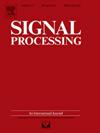SAR-CDL: SAR image interpretable despeckling through convolutional dictionary learning network
IF 3.4
2区 工程技术
Q2 ENGINEERING, ELECTRICAL & ELECTRONIC
引用次数: 0
Abstract
Deep learning-based approaches have shown advantages in the task of despeckling for SAR images. However, it is still difficult to explain due to the black-box nature of deep learning. Deep unfolding methods provide an interpretable alternative to building deep neural networks, which combines traditional iterative optimization methods with deep neural networks for image recovery tasks. In this paper, we propose an unfolded deep convolutional dictionary learning framework (SAR-CDL) for SAR image despeckling. A new variational model based on convolutional dictionary for removing multiplicative noise is proposed. The alternate direction multiplier method combining deep learning method are used to optimize the variational model, which can parameterize the model by deep learning in an end-to-end learning manner and avoid the large workload of the tuning process. The performance of the proposed SAR-CDL is validated on both simulated and real SAR datasets. The experimental results show that the proposed model outperforms many state-of-the-art methods in terms of quantitative metrics and visual quality, with a stronger ability to recover the fine structure and texture of the SAR images. In addition, the proposed SAR-CDL is robust to the size of the training set and can achieve appropriate results while reducing the training dataset.
基于卷积字典学习网络的SAR图像可解释去斑算法
基于深度学习的方法在SAR图像去斑任务中显示出优势。然而,由于深度学习的黑箱性质,这仍然很难解释。深度展开方法为构建深度神经网络提供了一种可解释的替代方法,它将传统的迭代优化方法与深度神经网络相结合,用于图像恢复任务。在本文中,我们提出了一种展开的深度卷积字典学习框架(SAR- cdl)用于SAR图像去噪。提出了一种新的基于卷积字典的乘性噪声去除变分模型。采用交替方向乘法相结合的深度学习方法对变分模型进行优化,以端到端学习的方式通过深度学习对模型进行参数化,避免了调优过程的大工作量。在模拟和真实SAR数据集上验证了所提出的SAR- cdl的性能。实验结果表明,该模型在定量指标和视觉质量方面都优于许多现有的方法,具有更强的恢复SAR图像精细结构和纹理的能力。此外,本文提出的SAR-CDL对训练集的大小具有鲁棒性,可以在减少训练集的同时获得适当的结果。
本文章由计算机程序翻译,如有差异,请以英文原文为准。
求助全文
约1分钟内获得全文
求助全文
来源期刊

Signal Processing
工程技术-工程:电子与电气
CiteScore
9.20
自引率
9.10%
发文量
309
审稿时长
41 days
期刊介绍:
Signal Processing incorporates all aspects of the theory and practice of signal processing. It features original research work, tutorial and review articles, and accounts of practical developments. It is intended for a rapid dissemination of knowledge and experience to engineers and scientists working in the research, development or practical application of signal processing.
Subject areas covered by the journal include: Signal Theory; Stochastic Processes; Detection and Estimation; Spectral Analysis; Filtering; Signal Processing Systems; Software Developments; Image Processing; Pattern Recognition; Optical Signal Processing; Digital Signal Processing; Multi-dimensional Signal Processing; Communication Signal Processing; Biomedical Signal Processing; Geophysical and Astrophysical Signal Processing; Earth Resources Signal Processing; Acoustic and Vibration Signal Processing; Data Processing; Remote Sensing; Signal Processing Technology; Radar Signal Processing; Sonar Signal Processing; Industrial Applications; New Applications.
 求助内容:
求助内容: 应助结果提醒方式:
应助结果提醒方式:


